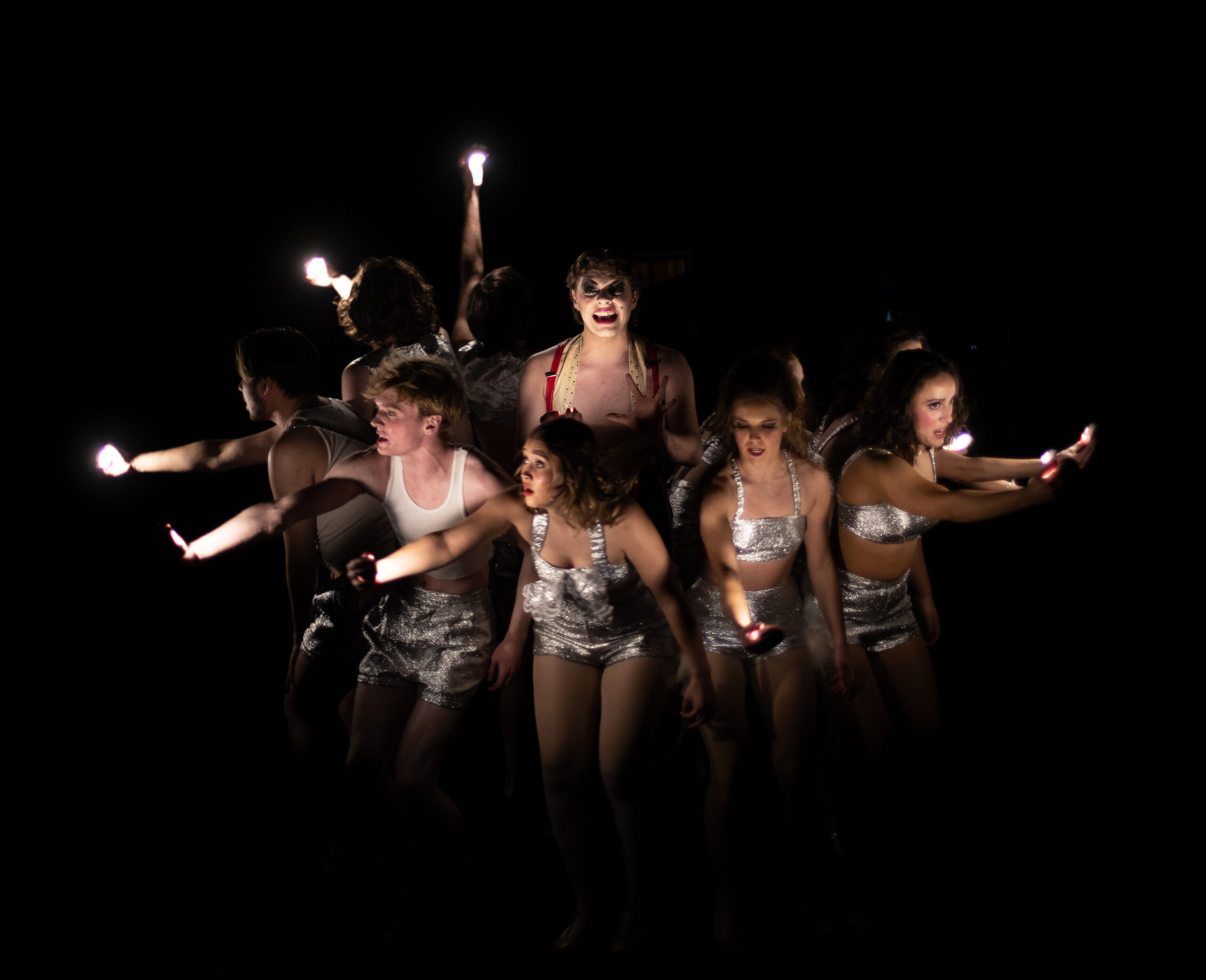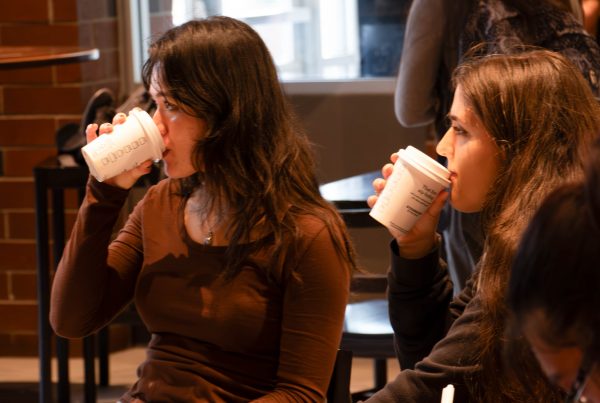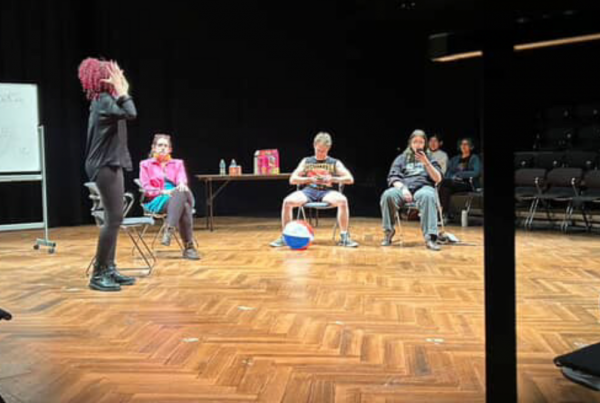For a Department of Theatre and Dance struggling to get by after key staff departures, the technically — and textually — demanding musical “Cabaret” comes as a startling choice of flagship production.
Following last semester’s student-directed one-acts and a stripped-down, tech-lite rendition of the musical “9 to 5,” “Cabaret” sees the department return to the Redfield Studio Theater. The cramped venue doesn’t provide for microphones or extensive sets, and what little professional lighting equipment it has remains out of reach until the department’s vacancies are filled.
“9 to 5” and the student-directed one-acts dealt with this problem by leaving the standard house lights up, as if inviting the audience to an early-stage rehearsal.
True to form, “Cabaret” has quite a different solution.
At the top of the show, the Redfield Studio Theater goes pitch-black. For every lighting cue that would otherwise be a seamless transition in a traditional theater, it is largely the performers, undisguised, who place and operate lights pulled from household sources.
The confined space forces the set to spill into the audience. A front-row seat is literally a table at the musical’s central setting, the Kit Kat Klub. Ensemble performers regularly and rigorously involve viewers, and the fourth wall is readily permeable thanks to audience proximity.
And when the musical takes its notorious dark turn, the blurred line between reality and revue comes in chillingly effective service of the political context. Following an American writer through his stay in Berlin, the semi-autobiographical book-turned-play-turned-musical sinks the viewer slowly into a climate of rising facism.
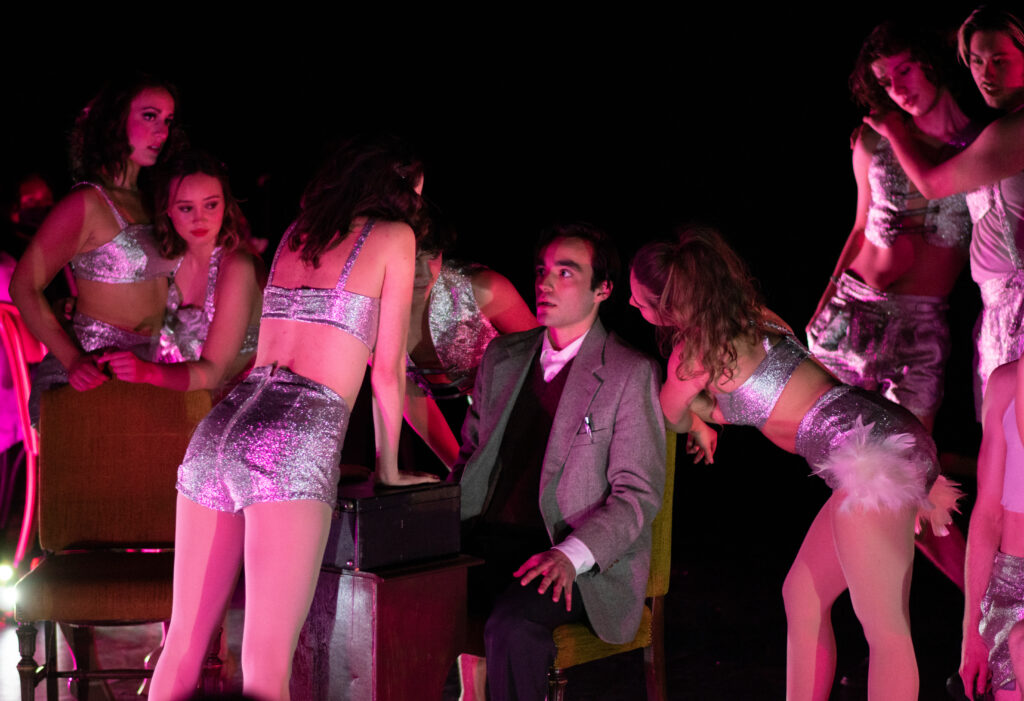
The American writer Clifford Bradshaw, played by Nick Farro, has an eerie first encounter with the dancers of the Kit Kat Club.
While the performers assure us repeatedly that “there are no troubles here,” the musical takes place in 1929, a time in which the Nazis are winning hearts and minds in a dangerous, racist bid for power. We, like the characters, are encouraged to pretend nothing’s amiss: it’ll pass, the country’s just struggling, it’s only happening out there.
It’s to this production’s great strength that the distinction between “in here” and “out there” is shattered before scene one. Thanks to director Yassi Jahanmir’s inventive use of the venue and the cast’s electric boldness in their interactions with the audience, this rendition of “Cabaret” is precisely what it’s meant to be: great fun…until it’s very, decidedly, not.
In a show with such striking range, the full cast is in for grueling emotional work. A rollicking opening number, “Willkommen”, sees a wickedly charismatic Emcee — played by Lucas Moir — bring 1929 Berlin’s reckless, hedonistic energy to the too-close stage. The ensemble, as the club’s provocative dancers, make short work of enacting a spell of carelessness in the face of coming doom.
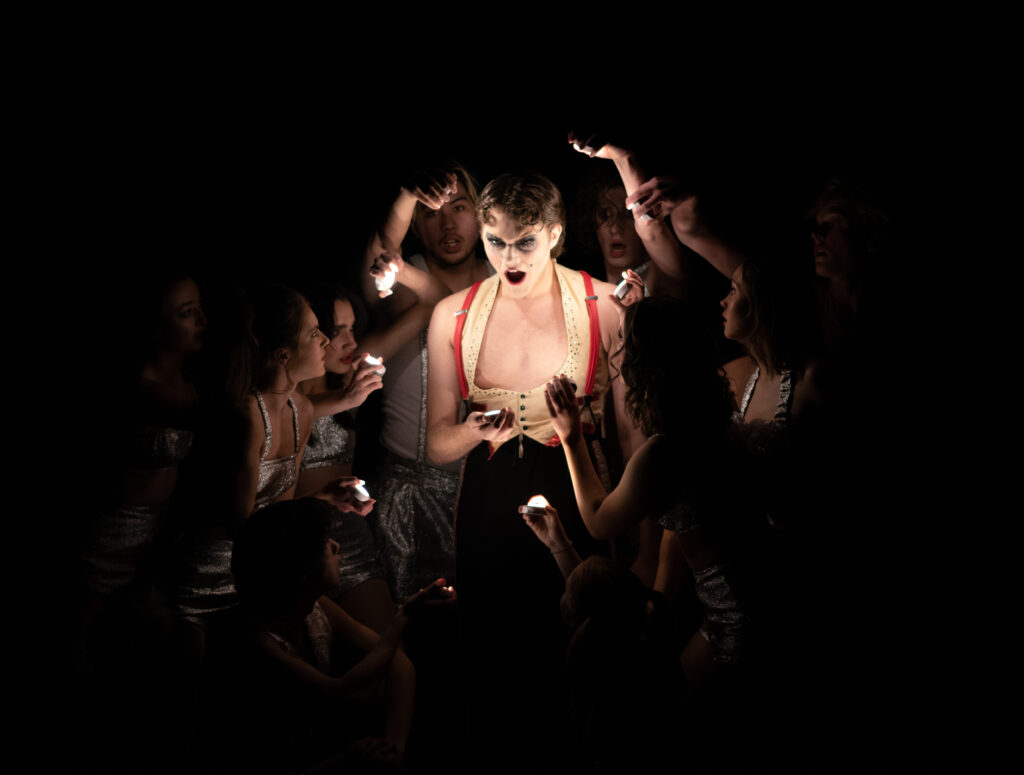
Lucas Moir, as the enigmatic Emcee, in “Money” with the musical’s stellar ensemble. Without technical support, the production had to turn to unconventional sources of lighting.
Moir, as a performer, strikes the perfect balance between intrigue and inscrutability. The Emcee is no tidy metaphor for a demagogue: Moir layers pretense, sexuality and a faint but distinctive undercurrent of fear to make the character as sincere as he is sinister. The strongest impression he leaves is initially that you’re supposed to ignore the outside realm of politics, but in a subtly-executed turn of pitch, you’re quietly begged to resist it.
By the time you’re loudly begged to resist it, of course, it’s too late.
In what a more traditional framing would offer as our point-of-view protagonists, the English emigré Sally Bowles — played by Jasmine Johnson — and the American writer Clifford Bradshaw — played by Nick Farro — make painfully human bystanders.
Sally, a strapped-for-cash dancer at the Kit Kat Klub, embodies the willful, uninvolved disinterest in politics that the musical expertly critiques. Johnson, however, makes sense of her apathy, digging deep into the desperation that makes her willing to look the other way. She gets the chance to shine as a vocalist often, but it’s when the polish comes off and her voice goes raw that she reaches top form.
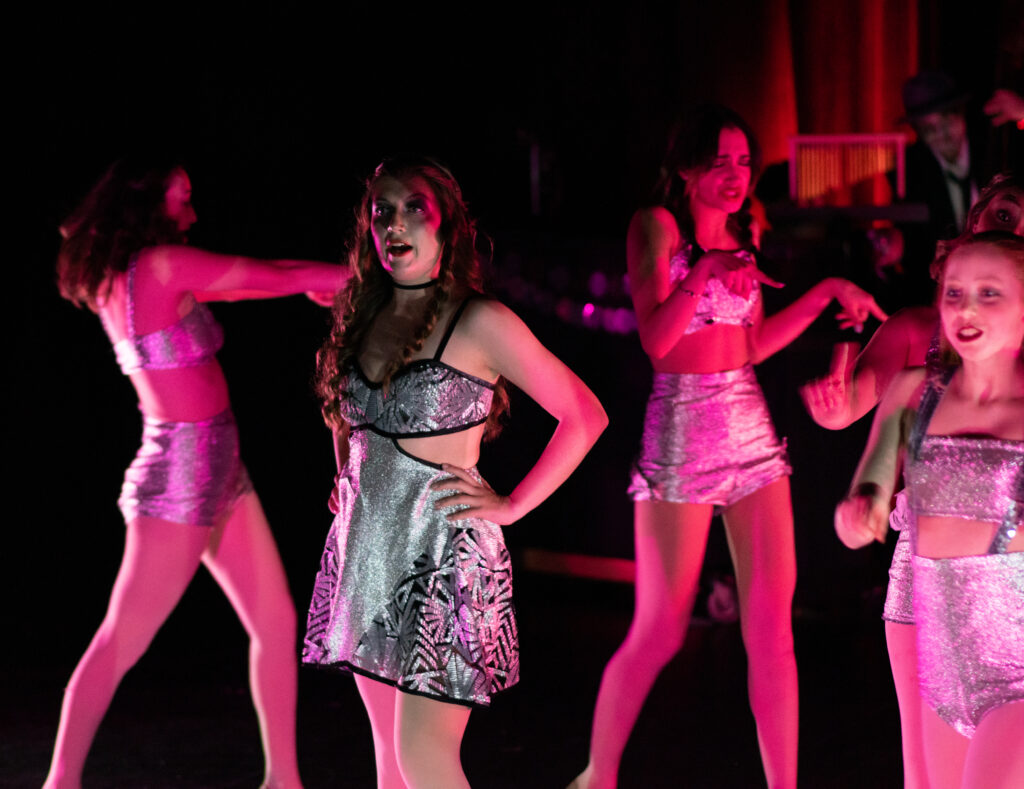
Jasmine Johnson, as Sally Bowles, in “Don’t Tell Mama,” the character’s first number, backed by members of the ensemble.
Johnson is of course matched in musical prowess by her backing ensemble, a highly courageous lineup of singers and dancers who fill out the staff of the Kit Kat Klub. On top of the show’s dynamic dance numbers, they artfully manage a litany of light cues. Many of these light cues are during such numbers, with the arrangement on stage changing so quickly, it’s almost dizzying — and that’s just for the audience.
When the time comes to turn on a dime from oblivious to ominous, the ensemble — with special attention to Nina Ferreira Forline as Fritzie and Coy Romo as Hans — meets the charge without missing a beat. Romo evokes a delicate, lingering horror when the show’s first clear glimpses of facism arrive in Act One’s “Tomorrow Belongs To Me”.
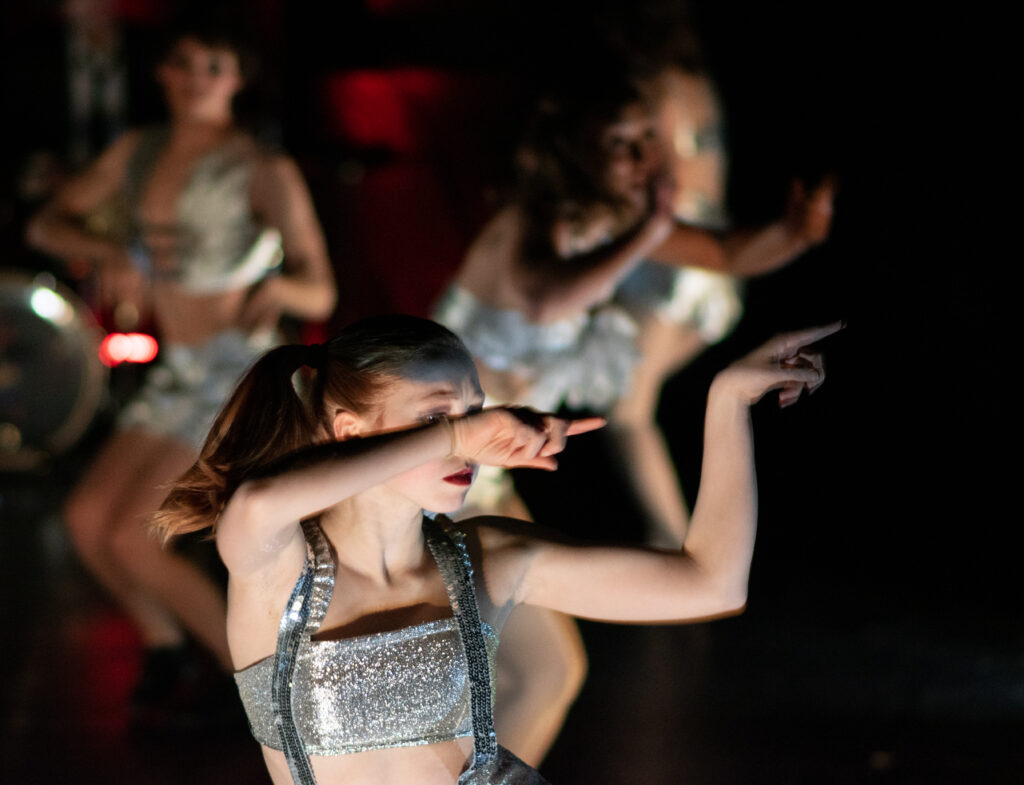
Miela Offerle, a member of the ensemble, dances as Helga in “Cabaret.” Offerle and her fellow performers placed and operated repurposed lights during the production.
Musically and aesthetically, the production aptly departs from a strict adherence to its 1929-30 setting. Nate Hodges, the show’s choreographer, resists iconic choreographer Bob Fosse’s long shadow over the show, and the cabaret dancers’ costumes evoke modern clubwear.
Aren Long, as music director, uses the stripped-back instrumentation required by the venue as an opportunity to make the score reach eerily into the present moment. The percussion in numbers like “Money” and “Mein Herr” is contemporary and propulsive, asking us as we leave the theater to consider what we’re trying to dance away today.

Members of the ensemble perform an inventively-lit number, “Mein Herr,” in Act One. Music director Aren Long’s stripped arrangements of “Cabaret” angled for the contemporary.
The show’s subtle treasures, however, can be found in Fräulein Schneider, played with sobering realism by Danielle Hunt, and Herr Schultz, played with boundless tenderness by Luis Galvez, who also served as the production’s dramaturg.
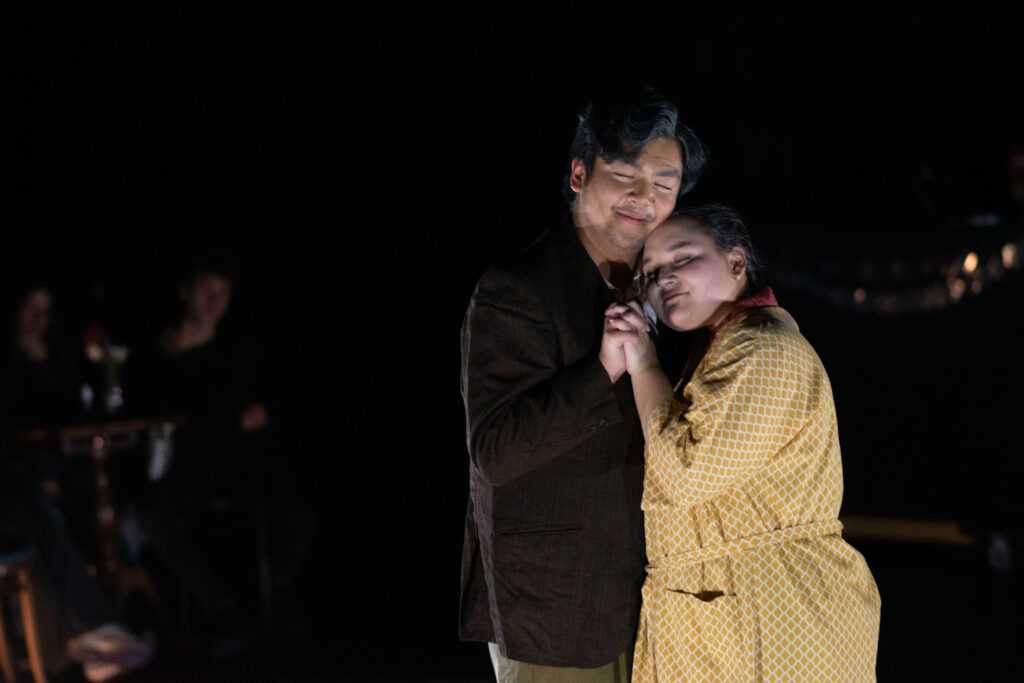
Luis Galvez as Herr Schultz (left) shares a duet with Danielle Hunt as Fräulein Schneider (right). Together, the two achieved a deeply moving command of the stage.
Fräulein Schneider, Clifford Bradshaw’s spinsterly landlady, features in a desperately earnest love story with Herr Schultz. Their three numbers together are among the production’s most resonant moments. And the terror Schultz faces as a Jewish man in a culture of now-overt antisemitism is an awful reminder that seemingly abstract political shifts threaten and kill real people.
Despite the personal moral ambiguity handled deftly by the cast and crew, “Cabaret” lands its warnings loud and clear: this is the dire cost of political indifference.
Peregrine Hart can be reached via email at peregrineh@unr.edu or via Twitter @pintofperegrine.

